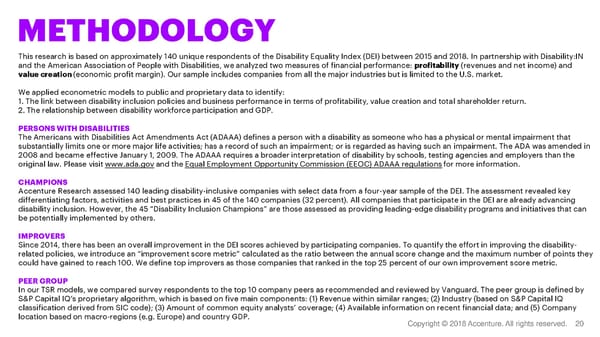METHODOLOGY This research is based on approximately 140 unique respondents of the Disability Equality Index (DEI) between 2015 and 2018. In partnership with Disability:IN and the American Association of People with Disabilities, we analyzed two measures of financial performance: profitability (revenues and net income) and value creation (economic profit margin). Our sample includes companies from all the major industries but is limited to the U.S. market. We applied econometric models to public and proprietary data to identify: 1. The link between disability inclusion policies and business performance in terms of profitability, value creation and total shareholder return. 2. The relationship between disability workforce participation and GDP. PERSONS WITH DISABILITIES The Americans with Disabilities Act Amendments Act (ADAAA) defines a person with a disability as someone who has a physical or mental impairment that substantially limits one or more major life activities; has a record of such an impairment; or is regarded as having such an impairment. The ADA was amended in 2008 and became effective January 1, 2009. The ADAAA requires a broader interpretation of disability by schools, testing agencies and employers than the original law. Please visit www.ada.gov and the Equal Employment Opportunity Commission (EEOC) ADAAA regulations for more information. CHAMPIONS Accenture Research assessed 140 leading disability-inclusive companies with select data from a four-year sample of the DEI. The assessment revealed key differentiating factors, activities and best practices in 45 of the 140 companies (32 percent). All companies that participate in the DEI are already advancing disability inclusion. However, the 45 “Disability Inclusion Champions” are those assessed as providing leading-edge disability programs and initiatives that can be potentially implemented by others. IMPROVERS Since 2014, there has been an overall improvement in the DEI scores achieved by participating companies. To quantify the effort in improving the disability- related policies, we introduce an “improvement score metric” calculated as the ratio between the annual score change and the maximum number of points they could have gained to reach 100. We define top improvers as those companies that ranked in the top 25 percent of our own improvement score metric. PEER GROUP In our TSR models, we compared survey respondents to the top 10 company peers as recommended and reviewed by Vanguard. The peer group is defined by S&P Capital IQ’s proprietary algorithm, which is based on five main components: (1) Revenue within similar ranges; (2) Industry (based on S&P Capital IQ classification derived from SIC code); (3) Amount of common equity analysts’ coverage; (4) Available information on recent financial data; and (5) Company location based on macro-regions (e.g. Europe) and country GDP. Copyright © 2018 Accenture. All rights reserved. 20
 Unlocking Future Value From Disability Inclusion Page 19
Unlocking Future Value From Disability Inclusion Page 19 